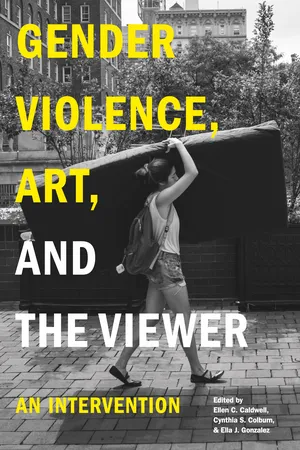
Gender Violence, Art, and the Viewer
An Intervention
- English
- PDF
- Available on iOS & Android
Gender Violence, Art, and the Viewer
An Intervention
About this book
The works covered in college art history classes frequently depict violence against women. Traditional survey textbooks highlight the impressive formal qualities of artworks depicting rape, murder, and other violence but often fail to address the violent content and context. Gender Violence, Art, and the Viewer investigates the role that the art history field has played in the past and can play in the future in education around gender violence in the arts. It asks art historians, museum educators, curators, and students to consider how, in the time of #MeToo, a public reckoning with gender violence in art can revitalize the field of art history.
Contributors to this timely volume amplify the voices and experiences of victims and survivors depicted throughout history, critically engage with sexually violent images, open meaningful and empowering discussions about visual assaults against women, reevaluate how we have viewed and narrated such works, and assess how we approach and teach famed works created by artists implicated in gender-based violence.
Gender Violence, Art, and the Viewer includes contributions by the editors as well as Veronica Alvarez, Indira Bailey, Melia Belli Bose, Charlene Villaseñor Black, Ria Brodell, Megan Cifarelli, Monika Fabijanska, Vivien Green Fryd, Carmen Hermo, Bryan C. Keene, Natalie Madrigal, Lisa Rafanelli, Nicole Scalissi, Hallie Rose Scott, Theresa Sotto, and Angela Two Stars. It is sure to be of keen interest to art history scholars and students and anyone working at the intersections of art and social justice.
Frequently asked questions
- Essential is ideal for learners and professionals who enjoy exploring a wide range of subjects. Access the Essential Library with 800,000+ trusted titles and best-sellers across business, personal growth, and the humanities. Includes unlimited reading time and Standard Read Aloud voice.
- Complete: Perfect for advanced learners and researchers needing full, unrestricted access. Unlock 1.4M+ books across hundreds of subjects, including academic and specialized titles. The Complete Plan also includes advanced features like Premium Read Aloud and Research Assistant.
Please note we cannot support devices running on iOS 13 and Android 7 or earlier. Learn more about using the app.
Information
Table of contents
- COVER Front
- Copyright Page
- Table of Contents
- Acknowledgments
- Introduction
- Chapter 1: Women and Violence in Ancient Greek Art Subverting the Dominant Narrative
- Chapter 2: Invisible Casualties Gender Violence in Assyrian Relief Sculptures
- Chapter 3: An Unmentionable History The Stigma of Sodomy and Images of Violence Toward Queer and Trans Peoples in Premodern Europe
- Chapter 4: Breaking the Silence Depictions of Gender-Based Violence and Sexual Violation in Italian Renaissance and Baroque Art
- Chapter 5: Teaching About Gendered and RacializedViolence in Colonial Mexican ArtThe Case of Malintzin and Other Challenges
- Chapter 6: Sexing the CanvasThe Rape Narrative of the Black Female Body in Western History Paintings
- Chapter 7: Cultivating a Humanizing Gaze Viewership, Consumption, and Complicity in Art and Film After #MeToo
- Chapter 8: Why It’s Impossible to Separate the Art from the Artist An Educator’s Experience with Gauguin and Picasso
- Chapter 9: To Censor or to Teach Educational Reflections on a Foundational Exhibition
- Chapter 10: An Overwhelming Response Gender-Based Violence and Contemporary Feminist Art
- Chapter 11: An Overwhelming Response Gender-Based Violence and Contemporary Feminist Art
- Chapter 12: Bring Her Home Awareness, Advocacy, Resistance, and Healing
- Chapter 13: Gender Violence, Censorship, and Erasure A Conversation with Ria Brodell About Contemporary Art, Practice, and Pedagogy
- Chapter 14: Amio Gender-Based Violence in Contemporary Bangladeshi Art
- Chapter 15: Anti-Rape and Anti-Incest Counternarratives Art in the United States Since the 1960s andin the Wake of the #MeToo Movement
- Chapter 16: Considering Unseen Violence Zanele Muholi’s Faces and Phases
- Index